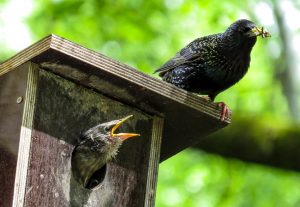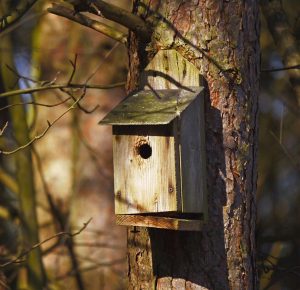Not all bird boxes are used during mating season; birds are fickle. If your box has housed a breeding pair and a brood or two, when the young have fledged you might wonder, should I remove old bird boxes.
You might have concerns that the same birds may try to return and use them the following year. You might also worry that disturbing the box might discourage any future birds from nesting.
Hopefully, my article will put your mind at ease, giving you a couple of options for the best things to do for our feathered friends.
Old bird boxes should always be removed – but only to be cleaned or stored. As the materials that the birds used to build the lining of the box start to break down, mold, fungus, bacteria, mites, and other pests form.
If these remain in the box, they will pose a threat to any future inhabitants. They are hazardous, toxic, and may result in their death.
Taking a bird box down to clean leaves you with 2 options.
- Store the box in readiness for the next breeding season.
- Convert it into a roosting box to provide a safe winter space for our song birds.
Let’s look at both options in more detail.
Table of Contents
How to clean a bird box for winter storage
The first thing is to remove any debris from the box. Sadly, there may be unhatched egg or chicks that never formed properly. These should be disposed of; remember, it is illegal to keep bird’s eggs.
Secondly, the box should be thoroughly sanitized. Hot water alone should do the job, or you can use a very diluted bleach solution.
Allow the box to air dry. This may take a while but storing it damp will encourage mould.

Next, inspect for any damage. The drainage holes may have become clogged, there might be splinters, and any seams or the entrance hole may need a repair.
Finally, store each box in a sealed plastic bag and put it somewhere dry until early next spring.
How to convert a bird box to a winter roosting box
Many non-migratory birds prefer to winter close to the territory where they raised their brood. As temperatures drop and conditions become harsher, birds, particularly cavity nesters and those that usually like to nest in bird boxes, search for a warm place to roost overnight.
Garden birds appreciate that there’s safety in numbers and look for somewhere secure for them to roost in groups.
A bird box is the ideal place, however; there are a few changes to be made to encourage as many birds as possible.
- Start by following the cleaning steps above, the box should be sanitized.
- While carrying out any repairs, block most of the ventilation holes to help retain the heat. Small pieces of foam will do the job, or a smooth coating of silicone on the outside. This also serves to moisture-proof the box.
- Add more perches inside. Twigs wedged across the box at different heights will suffice. This prevents the birds at the bottom from being smothered when lots of birds roost together.
- If the shape of the box allows it, invert the front panel. Remember, warm air rises and with the hole at the top of the box, it escapes. Any solar or body heat is enclosed in the house, keeping all of the occupants that little bit warmer.
- Lining the base of the box with wood shavings or sawdust provides a further layer of insulation.
The positioning of your bird box is important. It needs to be in such a place that it takes advantage of any winter sunshine. At the same time it should have it’s doorway facing away from any oncoming winds.
Why do birds use a box one year and not the next
This happens to us all, even the most ardent twitchers. Birds are fickle and like things ‘just so’.
However, if your box has been inhabited by a family one year, in my case by blue tits, and has no interest in subsequent breeding seasons, they’re not happy with something.

Have you cleaned and dried the box, removing all signs of any previous occupants? Most birds won’t enter a bird box if there is sign of previous tenants.
Consider moving it to a quieter, more secluded part of the garden.
New family pets, cats that patrol their territory or dogs that play and bark in the garden may deter birds from nesting. They are perceptive and will only use a bird box after a full recce of the area to ensure that it is secure.
Final thoughts
There are more than 60 species of garden birds in the UK known to use bird boxes.
Blue and great tits are the most prolific users in urban gardens. Watching any bird raise a family of young in your garden is a wonderful site to behold.
To encourage them to return year upon year, or to ‘winterize’ your house, you should remember to remove old bird boxes in late October/early November.
Whether you store them or create roosting boxes out of them, they should be cleaned and made safe, ready for the beginning of breeding season in very early spring.
